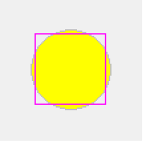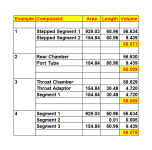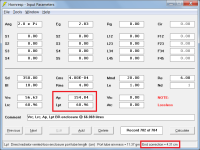To model the main (first) enclosure resonance.
Are you saying that the length of the cabinet is being used to calculate the effects of the wave bouncing around inside the cabinet? If that was the case then wouldn't you need more than just a volume? I mean how can you predict a bounce pattern if you don't know the other dimensions?
I suppose that means end correction?
At the port exits there is some "outside" air coupled to the air in the port. That added mass adds a virtual increase of port length.
Not sure if that is it, but I see where you're thinking is at. There would be some transitional air between that which is in the port and that which is in the room. Not sure what that has to do with the required user input to be part of a help label, it only serves to confuse the user (case in point) if it isn't directly tied to what needs to go in the box. I could understand providing that information in another place like a text box if you were going to make that a user configurable parameter like you are allowing the user to enter a custom value for a flare effect.
Same goes for the weight of the air, unless your going to provide some kind of user editable field (like if the user is living in the mountains) then that kind of math / information can be hidden from the user since there is no way for them to change it, or need to know it.
So out of Lpt Direct radiator vented-box enclosure port tube length (cm) Port tube air mass = 0.60 gm End connection = 2.45cms. it looks the only thing I really need to concern myself is with the port length?
As far as I know Hornresp assumes a cylindrical volume and thus only needs length and volume to define the geometry. While a cylindrical enclosure is not very common it is very useful to see the first strong enclosure resonance of the longest internal length and its interaction with eventual port resonances.If that was the case then wouldn't you need more than just a volume? I mean how can you predict a bounce pattern if you don't know the other dimensions?
here is an example I did, including simulation and measurement graphs and identification of resonance peaks further down in the post.
Last edited:
A circle will have a larger diameter than a square of the same volume, but the square will probably have a a bigger diagonal measurement.
A circle will have a larger diameter than a square of the same area 🙂
Attachments
I'm guessing the 50.70 version of HR is the reason for the volume variance between the Stepped model (66.073 liters) and the other 3 models (66.069 liters).
The volume of each component in litres is rounded to 3 decimal places and the rounded component volumes are then added together to obtain the system volume. This is why total volumes for seemingly identical systems can sometimes be slightly different.
The breakdown of volumes for the 4 examples you gave are shown in Attachment 1.
Notes:
1. Because example 2 uses Ap and Lpt to specify the port tube, an internal end correction of 4.31 cm is automatically added to the length used in the calculations, as shown in Attachment 2.
2. The length of segment 3 in example 4 should be 60.96 not 60.90.
Attachments
Ahh yes. I often get terms mixed up.A circle will have a larger diameter than a square of the same area 🙂
At the port exits there is some "outside" air coupled to the air in the port. That added mass adds a virtual increase of port length.
Just to clarify, the length correction calculated by Hornresp applies to the internal end of the port tube. The port exit does not require a length correction because the radiation impedance is used instead.
Just to clarify, the length correction calculated by Hornresp applies to the internal end of the port tube. The port exit does not require a length correction because the radiation impedance is used instead.
So when we are entering port length are we supposed to add that extra number, or are you merely telling us that is going to be added to the length?
As far as I know Hornresp assumes a cylindrical volume and thus only needs length and volume to define the geometry.
Cylinders are defined in Hornresp three ways:
1. Volume and length (eg. rear chamber - Vrc and Lrc)
2. Volume and cross-sectional area (eg. throat chamber - Vtc and Atc)
3. Cross-sectional area and length (eg. port tube - Ap and Lpt)
Not surprising I got very different results. Can anyone spot what I did wrong?
Also am I supposed to subtract, add driver volumes? I figure since we aren't asked to pick a driver to identify it, driver volumes aren't considered, so I am guessing we are looking at box volume only... So I have put in 101.5 litres.



Also am I supposed to subtract, add driver volumes? I figure since we aren't asked to pick a driver to identify it, driver volumes aren't considered, so I am guessing we are looking at box volume only... So I have put in 101.5 litres.
So when we are entering port length are we supposed to add that extra number, or are you merely telling us that is going to be added to the length?
If Ap and Lpt are used to specify the port tube as was done in example 2, then Hornresp will automatically add the end correction.
If a segment is used to specify the port tube as was done in examples 1, 3 and 4 then the user needs to be aware that an internal end correction will not be automatically added, and account for that accordingly (it cannot be automatically included because Hornresp has no way of knowing what the segment is being used for).
Not surprising I got very different results
The 1.63 metre tube is acting more like a transmission line than a bass reflex port mass. BassBox cannot accurately model this.
Also, you have specified 4 drivers in Hornresp.
Not sure how that happened think it carried it over from something I tried before.Also, you have specified 4 drivers in Hornresp.
This looks a bit closer. Your right that is more like a transmission line. I put a far more sensible port in (not suggested to achieve xmax) and it still show the same response curve, so clearly it is not factoring that in. That being the case how can I trust it to build a box (and how far out is stuff I used it for before)...
Took a guess at something more like what I think a port should be, and I got something that looks like a woofer frequency response. I don't know what things like vent velocity are going to be, or if it is going to exceed xmax, as I can't see that info in the program. But I now have a starting point for a simple BR box.
How do you tackle things like acoustic dampening? Just add a bit to the box volume?

How do you tackle things like acoustic dampening? Just add a bit to the box volume?
Took a guess at something more like what I think a port should be, and I got something that looks like a woofer frequency response.
It would be worth checking that the driver parameter values are correct.
Bl is specified as 11.9 T.m in BassBox and 24.19 T.m in Hornresp, for example.
I don't know what things like vent velocity are going to be, or if it is going to exceed xmax, as I can't see that info in the program.
1. Calculate the acoustical power response.
2. Select menu commands Tools > Output > Port.
3. Select menu commands Tools > Particle Velocity > Port Outlet.
How do you tackle things like acoustic dampening?
Not necessary - you are using the 'resonances masked' option.
or if it is going to exceed xmax
Calculate the results and select menu commands Window > Diaphragm Displacement.
Good spot. The driver in BBP6 is loaded from a database, so it might have wrong information in it. The Bl is 23.8Bl is specified as 11.9 T.m in BassBox and 24.19 T.m in Hornresp, for example.
Also, how should I calculate port corner length compared to straight length?
How about these parts?:
View attachment 1282716
Use the center line method.
To me, the port length is the external width plus the external depth of the rear chamber.
Oh goodie, my Fr has just turned into a Ap, now what does that mean... Ap Direct radiator vented-box enclosure port cross-sectional area (sq cms) Helmholtz resonance frequency = 58.4 hertz
Just put that into Gooogle translate for people that speak English... hmmm port cross sectional area.. OK so that is just a complicated way of saying the area of the port... So now because there isn't an area calculator in the software (at least not where it would be obvious and useful) it looks like I am going to have to do some math to work out how big of a port I am asking for to get this number since we tend to think of ports in dimensions not area.
Being lazy just going to ask Gemini that is likely to get it wrong anyway... 7.96cm circle diameter. OK can now visualise that.
If I have a Vrc of 27.5 litres why do I now need a Lrc? All I need is a volume, unless it plans to use the Lrc to scale the drawing...Anyway letting that go and moving on.
Lpt... OK what is that? I don't have that in my list. Lpt Direct radiator vented-box enclosure port tube length (cm) Port tube air mass = 0.60 gm End connection = 2.45cms.
Let's break this down... OK yes we are going to need a length to work out the volume of the port, since we already have the surface area. That makes sense. We then have a weight of the air in that volume, yep that makes sense too. End connection.... Get out the translator again... Logic would suggest that is the size where it connects to the box?, or maybe the opening of the port? but the port diameter is 7.96cms where did this 2.45cms number come from???
OK brain is stuck again. Push forward please.
Of course you have to do some math. HR doesn't how big/small or loud/low you want YOUR enclosure to be.
For port diameter, I multiply the total Sd by 0.33 to let me know the smallest diameter I can use for the model. The same principle applies for straight and positive flare throats and negative flare mouths.
If I have a Vrc of 27.5 litres why do I now need a Lrc? All I need is a volume, unless it plans to use the Lrc to scale the drawing...Anyway letting that go and moving on.
Again, HR doesn't know what shape you want YOUR enclosure to be.
By providing the depth (Lrc), you will get an idea of the shape of the enclosure.
I usually default to 1in2 larger than the driver diameter for height and width.
Example: for a 12" driver, I would use an internal height and width of 13" x 13" since I'm a bandpass guy. The driver has to fit inside the enclosure.
So my Lrc might be 33.02cm (13") for a perfect cubed chamber.
- Home
- Loudspeakers
- Subwoofers
- Hornresp


